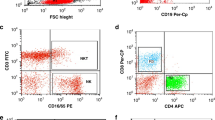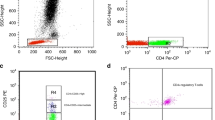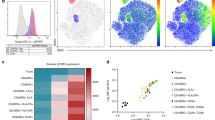Abstract
Background
Regulatory T cells (Tregs) are linked to a reduction in alloreactive immune responses, but few studies have investigated the impact of hydroxyurea (HU) therapy on Tregs in sickle cell disease (SCD).
Methods
Our case-controlled study presented here included two groups, the first comprising 60 pediatric SCD patients, 30 of whom did not receive any treatment and 30 who received HU, and the second group consisting of 30 healthy controls. Flow cytometry was used to evaluate the percentage of CD4+CD25+highFoxp3+ Tregs present and their phenotypes.
Results
The percentage of CD4+CD25+high Tregs was significantly increased in untreated SCD patients in comparison to treated SCD patients and controls. Conversely, treated SCD children had a lower percentage of CD4+CD25+high Tregs than controls. In addition, a significant increase in the percentage of CD4+CD25+highFoxp3+ Tregs was found in untreated SCD patients, compared to in HU-treated patients and controls. The percentage of naive CD45RA+ Tregs was significantly decreased in untreated SCD patients when compared to other groups.
Conclusions
Among children with SCD, HU treatment exhibited significant qualitative and quantitative effects on Tregs by decreasing their frequency, and increasing the proportion of naive CD45RA+ Tregs and reducing levels of the most suppressive Tregs: HLA-DR+, CD39+, and CD69+.
Impact
-
Among children with, SCD, HU treatment exhibited significant qualitative and quantitative effects on Tregs.
-
HU treatment in SCD decreases the frequency of Tregs, as well as the levels of the most suppressive Tregs: HLA-DR+, CD39+, and CD69+. At the same time, HU increases the proportion of naive CD45RA+ Tregs.
-
Our study showed the impact of HU therapy on Tregs in children with SCD.
Similar content being viewed by others
Introduction
Sickle cell disease (SCD) is a genetic autosomal +recessive disorder of hemoglobin (Hb) that results in altered properties of the Hb molecule, causing a tendency to polymerize in its deoxygenated state1. Several studies have shown that SCD patients are usually associated with alterations in the immune system that contributed to the pathology of SCD2. For years, immune aberrations in SCD have been mainly attributed to functional asplenia. More recently, however, it has been reported that the immune deviations in SCD extend beyond spleen problems, and SCD is now considered an inflammatory disorder with overstated immune activation2,3. This immune stimulation plays a vital role in the immunological issues exhibited by children with SCD, such as red blood cell (RBC) autoimmunization and alloimmunization and other hematopoietic problems, particularly after receiving human leukocyte antigen-mismatched blood transfusions3,4. Although many studies have reported immunological abnormalities with SCD, few studies have investigated, in detail, the immunophenotype of children with SCD at a steady state in order to determine the impact of hydroxyurea (HU) therapy on these immunological phenotypes.
Regulatory T cells (Tregs) are required for immune homeostasis and maintenance of self-tolerance5,6,7. Recently, Tregs have been implicated in the attenuation of alloreactive immune responses6 and their dysfunction may be linked to several immune disorders5,6,7. Newly produced Tregs, recently released from the thymus and having no antigen exposure experience, are called naive (or resting) Tregs. After activation, activated Tregs express several molecules connected with their suppressive role. Tregs can be divided into subsets based on their expression of these molecules, which include CD45RA, CD39, CCR7, and HLA‐DR7. Nearly 40% of Tregs present with surface HLA-DR. HLA-DR+ Tregs induce more intense and faster suppression than do HLA-DR− Tregs8. CD45RA− Tregs are known to be fully functional Tregs. CD39 expression is also involved in Tregs’ suppressive functions by degrading ATP to AMP6,7,9. In mice, all Tregs express CD39, but to a lesser extent than in human Tregs6,9. There are limited data regarding the influence of HU on Treg phenotypes in children with SCD. Therefore, we aimed to assess the impact of HU treatment on Treg frequency and phenotypes, as well as its clinical impact among children with SCD in Upper Egypt.
Patients and methods
Study participants
Our study was a case-controlled study conducted at the Pediatric Hematology Unit, Children’s Hospital, Assiut University, Egypt. The Ethical Committee of Assiut University approved all procedures in our research. Informed consent was obtained from all guardians of children included in the study. Sixty children with SCD were enrolled in this study—30 underwent HU therapy (group 2), and the other 30 did not receive any treatment (group 1). The study also included 30 healthy age- and sex-matched children as controls (group 3). Patients were categorized as group 2 if they had been taking HU for at least 1 year. The primary indications for HU were at least three vaso-occlusive crises (VOCs) or occurrences of acute chest syndrome (ACS) requiring hospitalization per year. HU was adjusted to a dose of 20–30 mg/kg/day, according to hematologic tolerance. All patients were clinically stable with no signs of any infections or complications for at least 1 month before the study. Children with SCD complications in 4 weeks before the study were excluded. All controls were healthy, with no history of blood disorders or inflammatory diseases.
Methods
We used the automated Coulter Gen S System 2 (Beckman-Coulter, CA) to assess the hematological parameters of all participants. Hb fraction S (HbS) and fetal Hb (HbF) were quantitated from patient samples via high-performance liquid chromatography, using the BIO-RAD Variant II system.
Flow cytometric detection of regulatory T cells and their phenotypes
Fluorescein isothiocyanate-conjugated Foxp3, phycoerythrin-conjugated CD25, peridinin-chlorophyll-protein-conjugated CD4, allophycocyanin (APC)-conjugated HLA-DR, APC-conjugated CD45RA, APC-conjugated CD69, and APC-conjugated CD39 were used to detect Tregs and their phenotypes. All monoclonal antibodies used were from Becton Dickinson (San Jose, CA), except CD25 (IQ Product the Netherland) and Foxp3 (Bioscience, CA). First, 100 µl of each blood sample was incubated with 10 µl of CD4, CD25, and CD45RA/CD39/HLA-DR/CD69 in separate tubes. After incubation for 20 min in the dark, RBCs were lysed, and samples were washed with phosphate buffer saline (PBS). A fixing solution was added to fix the cells, followed by incubation for 10 min. Afterward, cells were washed with PBS, and then a permeabilization solution and 10 µl of Foxp3 were added to each tube, followed by further incubation for 20 min. After washing, the cells were resuspended in PBS and analyzed via FACSCalibur flow cytometry with CellQuest software (Becton Dickinson Biosciences, CA). An isotype negative control was analyzed along with each sample. At least 20,000 cells were acquired, and forward and side scatter histograms were used to delineate the lymphocytes (R1), then CD4+ cells were gated. Total CD4+CD25+, CD4+CD25+low, CD4+CD25+high, and CD4+CD25+highFoxp3+ Tregs were evaluated as percentages of total CD4+ cells. The expression of Foxp3 on CD4+CD25+high cells was expressed as the geometric mean of fluorescence intensity. The expressions of CD45RA, CD69, CD39, and HLA-DR were evaluated on CD4+CD25+highFoxp3+ Tregs (Fig. 1), expressed as percentages of CD4+CD25+highFoxp3+ Tregs.
a Forward and side scatter histogram was used to define the lymphocytes population (R1). b The expression of CD4 on the lymphocyte’s population was detected, then CD4+ cells were gated for further analysis of CD25. c Different gates were drowning to define CD4+CD25− cells, CD4+CD25+low cells, and CD4+CD25+high cells. d The expressions of Foxp3+within CD4+CD25+high cells were assessed then the percentage of CD4+CD25+highFoxp3+cells (regulatory T cells) was detected. e–h The expressions of CD39, CD45RA, HLA-DR, and CD69 were then detected within the regulatory T cells (R6).
Statistical analysis
Data analysis was done in SPSS version 22. Data were expressed as mean and standard deviation (SD). Comparison between the groups was done with one-way ANOVA with multiple comparisons and between every two groups using the Mann–Whitney test. Correlations were calculated using the Spearman linear regression analysis. A p value of ≤0.05 is considered significant.
Results
A total of 60 children with SCD and 30 healthy controls were enrolled in this study. The ages of patients ranged from 3.5 to 12 years, with a mean ± SD of 9.66 ± 1.9 years. No significant differences in demographic data were found among patient groups 1, 2, and 3 (Table 1). Regarding hematological parameters, group 1 (no therapy) showed significantly lower values of Hb, mean corpuscular volume (MCV), HbF, RBCs, and hematocrit, and significantly higher values of HbS, white blood cells (WBCs), and total lymphocytic count when compared to group 2, which received HU treatment (Table 1). A comparison of group 1 to group 3 (controls) yielded similar results, with the one difference that HbF values were significantly higher in group 1 than in group 3 (Table 1). Group 2 showed significantly lower values of Hb, RBCs, and hematocrit and significantly higher values of HbF, HbS, MCV, and WBCs when compared to group 3. No statistically significant differences were found among the three groups regarding platelet count (Table 1). Regarding clinical variables, we observed a statistically significant difference in the rate of complications (VOC, ACS, and other pain crises) between treated and untreated SCD patients. The mean VOC rate/year was significantly lower in the HU-treated group than in the untreated group (0.75 ± 1.31 versus 1.84 ± 1.58; p = 0.001; Table 1). The overall ACS rate/year was also significantly lower in the HU-treated group than in the untreated group (0.08 ± 0.28 versus 0.35 ± 0.48; p = 0.004), with the same difference also occurring for pain crisis episodes (2.2 ± 2.5 versus 6.0 ± 6.6; p = 0.001; see Table 1).
The SCD patients who did not receive HU therapy had significantly higher percentages of total CD4+ Tregs than did HU-treated patients and controls (Table 2). Interestingly, HU-treated SCD patients also had a significantly higher percentage of CD4+ Tregs than did controls. The percentage of CD4+CD25+high Tregs was significantly higher in untreated SCD patients than in treated SCD patients and healthy controls, whereas treated SCD patients had a lower percentage of CD4+CD25+high Tregs than healthy controls. In addition, a highly significant increase in the percentage of CD4+CD25highFoxp3 Tregs was found in untreated SCD patients, when compared to HU-treated SCD patients and the healthy control group, and a higher percentage was observed in treated SCD patients than in controls (Table 2). The proportion of Tregs expressing CD69 and CD39 was higher in both treated and untreated SCD patients than in controls, with no significant difference between HU-treated and untreated patients. Furthermore, our results showed that the percentage of highly proliferative naive CD45RA+ Tregs was significantly decreased in untreated SCD patients in comparison to the HU group and controls, with no significant difference between the HU group and healthy controls. In addition, the percentages of HLA-DR+ Tregs were significantly higher in untreated SCD patients than in HU-treated patients and healthy controls (Table 2).
Discussion
Our study showed that children with SCD who received HU reported substantial clinical and hematological improvements, which is in line with other studies4,5,9,10. Furthermore, after 1 year of HU treatment, SCD patients showed a significant and persistent increase in Hb, MCV, and hematocrit values, and a reduction in the percentage of WBCs and platelet counts, results that are also in line with other studies4,5,9,10. Previous studies have reported significant clinical improvements, including decreases in blood transfusion rates, hospital admissions, and duration of hospital stay5,10. Charache et al. reported that higher MCV and mean corpuscular Hb post-treatment with HU may be attributed to increased Hb content of erythrocytes caused by changed membrane properties and water content in RBCs11.
Previous data have demonstrated the pivotal role of Tregs in immune suppression and the development of tolerance. In SCD, Tregs play a vital role in alloimmunization against RBC antigens, but few studies have focused on the functions and phenotypes of Tregs in children with SCD. Our study showed that both HU-treated and untreated SCD patients had higher levels of Tregs than did healthy controls, and that this level was significantly lower in HU-treated than untreated patients. This higher level of Tregs in our SCD patients could imply that Tregs have a role in the pathogenesis of SCD and immune suppression in those patients. The correction of this suppression in our SCD patients after treatment with HU was evidenced clinically by the reduction in the rate of complications, such as VOC and ACS, results that agreed with previous data12.
This study confirmed that untreated children with SCD had a lower percentage of naive CD45RA+ Tregs (i.e., increased levels of effector Tregs) than did those in the control group, whereas levels of CD45RA+ Tregs increased in HU-treated patients to near those of healthy controls. This could indicate that the reduction of less suppressive CD45RA+ Tregs may enhance the immune suppression of Tregs, and this may be associated with the pathogenesis of SCD. Our data are in line with those of a previous study, which reported a higher percentage of effector Tregs found in SCD patients9. Our study found high levels of the most suppressive Tregs—HLA-DR+, CD39+, and CD69+—in SCD patients who did not receive HU, supporting the hypothesis that the immunoregulatory functions of Tregs are overactivated in SCD patients, a problem that is corrected to some extent by HU treatment.
Conclusion
Among children with SCD, HU treatment has significant qualitative and quantitative effects on Tregs by decreasing their frequency and at the same time increasing the proportion of naive CD45RA+ Tregs, as well as reducing levels of the most suppressive Tregs: HLA-DR+, CD39+, and CD69+.
References
Borhade, M. B., & Kondamudi, N. P. In StatPearls (StatPearls Publishing, 2020).
Emokpae, M. A. et al. Relationship between neutrophil-to-lymphocyte ratio and inflammatory markers in sickle cell anaemia patients with proteinuria. Med. Sci. 4, 11 (2016).
Chou, S. T. et al. High prevalence of red blood cell alloimmunization in sickle cell disease despite transfusion from Rh-matched minority donors. Blood 122, 1062–1071 (2013).
Zahran, A. M. et al. Circulating microparticles in children with sickle cell anemia in a tertiary center in upper Egypt. Clin. Appl Thromb. Hemost. 25, 1076029619828839 (2019).
Zahran, A. M. et al. Effect of hydroxyurea treatment on the inflammatory markers among children with sickle cell disease. Clin. Appl Thromb. Hemost. 26, 1076029619895111 (2020).
Yazdanbakhsh, K. Immunoregulatory networks in sickle cell alloimmunization. Hematol. Am. Soc. Hematol. Educ. Program 2016, 457–461 (2016).
Vignali, D. A. et al. How regulatory T cells work. Nat. Rev. Immunol. 8, 523 (2008).
Baecher-Allan, C. et al. MHC class II expression identifies functionally distinct human regulatory T cells. J. Immunol. 176, 4622–4631 (2006).
Vingert, B. et al. Partial dysfunction of Treg activation in sickle cell disease. Am. J. Hematol. 89, 261–266 (2014).
Youssry, I. et al. Enhancing effect of hydroxyurea on Hb F in sickle cell disease: ten-year egyptian experience. Hemoglobin 41, 267–273 (2017).
Charache, S. et al. Effect of hydroxyurea on the frequency of painful crises in sickle cell anemia. Investigators of the multicenter study of hydroxyurea in sickle cell anemia. N. Engl. J. Med. 332, 1317–1322 (1995).
Rêgo, M. J. et al. Evaluation of CD4(+) CD25(+) FoxP3(+) T cell populations, IL-10 production, and their correlation with clinical and biochemical parameters in sickle cell anemia patients with leg ulcers. Cytokine 75, 310–315 (2015).
Acknowledgements
South Egypt Cancer Institute, Assiut, Egypt (No. 120-2017).
Author information
Authors and Affiliations
Contributions
A.M.Z., K.S., S.K., and A.E. designed the study, followed the patients, analyzed the data, and drafted the manuscript. A.Z. and H.F.H. performed all laboratory investigations in the study. K.I.E, K.S., and K.H.M. drafted the manuscript. All authors were involved in the critical analysis of the final version of the manuscript. All authors approved the manuscript as submitted and agree to be accountable for all aspects of the work.
Corresponding author
Ethics declarations
Competing interests
The authors declare no competing interests.
Consent statement
All caregivers of all participants have given their informed written consent.
Ethical approval
All protocols and investigations of our study followed the regulations of the research ethics committee of Assiut University (No. 120-2017).
Additional information
Publisher’s note Springer Nature remains neutral with regard to jurisdictional claims in published maps and institutional affiliations.
Rights and permissions
About this article
Cite this article
Zahran, A.M., Saad, K., Elsayh, K.I. et al. Regulatory T-cell phenotypes in children with sickle cell disease. Pediatr Res 91, 1203–1206 (2022). https://doi.org/10.1038/s41390-021-01627-y
Received:
Revised:
Accepted:
Published:
Issue Date:
DOI: https://doi.org/10.1038/s41390-021-01627-y
This article is cited by
-
Impact of hydroxyurea on lymphocyte subsets in children with sickle cell anemia
Pediatric Research (2021)




